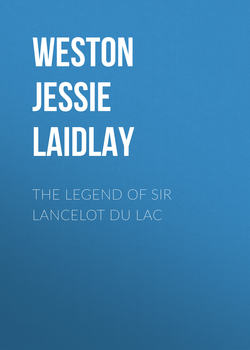The Legend of Sir Lancelot du Lac

Реклама. ООО «ЛитРес», ИНН: 7719571260.
Оглавление
Weston Jessie Laidlay. The Legend of Sir Lancelot du Lac
PREFACE
CHAPTER I
CHAPTER II
CHAPTER III
CHAPTER IV
CHAPTER V
CHAPTER VI
CHAPTER VII
CHAPTER VIII
CHAPTER IX
CHAPTER X
CHAPTER XI
CHAPTER XII
APPENDIX
Отрывок из книги
To the great majority of English readers, those who are familiar with the Arthurian legend through the pages of Malory and Tennyson, the name which occurs most readily to their minds in connection with the court and Table of King Arthur is that of Lancelot du Lac, at once the most gallant servant of the king, and the secret lover of the queen. To many the story of Lancelot and Guinevere is the most famous of all stories of unlawful love.
True, of late years the popularity of Wagner's music has made their ears, at least, familiar with the names of Tristan and Iseult. Still, that Tristan and Iseult were ever as famous as Lancelot and Guinevere, few outside the ranks of professed students of mediæval literature would believe; still fewer admit that the loves of Arthur's queen and Arthur's knight were suggested by, if not imitated from, the older, more poetic, and infinitely more convincing, Celtic love-tale; that Lancelot, as Arthur's knight and Guinevere's lover, is a comparatively late addition to the Arthurian legend.
.....
The poem of Ulrich von Zatzikhoven has scarcely received the attention which, as a factor in the criticism of the legend, it undoubtedly demands. The questions arising out of it are not only interesting, but, as I shall presently show, in one instance at least, of the very highest importance. The questions may be grouped as (a) those relating to the structure and sources of the poem itself; (b) those which affect its relation to the other Lancelot romances. For the first it is obvious that we are dealing with a poem of very loose construction; the various parts do not harmonise with each other, and no attempt has been made to make them do so. Thus we have no fewer than four love affairs attributed to Lanzelet, and in three out of the four he weds the lady; yet these amours, one of which is subsequent to his marriage with Iblîs, are dropped as of no account. Professor Foerster23 considers that this looseness of construction points to a late date, and that the source of the Lanzelet was a biographical romance of the weakest order. According to Professor Foerster the clearer the composition, the better knit the incidents, the older the romance.
Now it seems to me that there are two orders of ill-constructed romances, and that we shall do well to differentiate between them. In one case we have a number of incidents of secondary character, obviously borrowed or imitated from those occurring elsewhere, strung together more or less cleverly on the thread of a hero's individuality. The incidents are all to be found in other romances, and as a rule none of them have any suggestion of Celtic or mythic origin. The literary style is superior to the matter. Such romances are e.g. Rigomer, Torec, Le Chevalier à la Manche. A very favourable example is Méraugis de Portlesguez. These are all certainly late romances.
.....